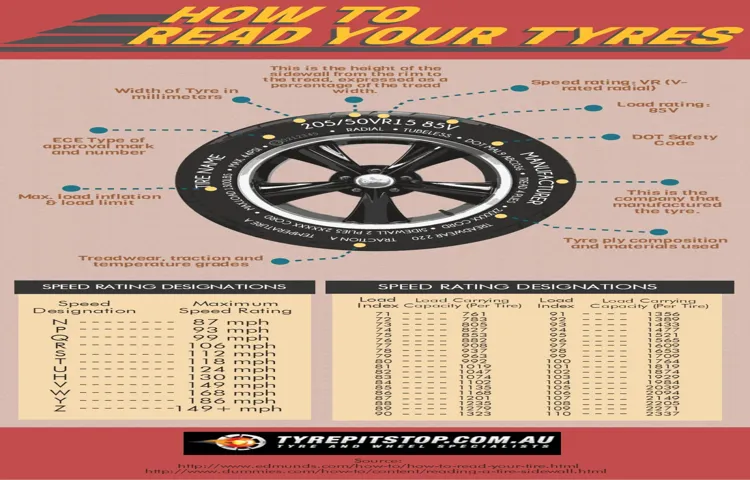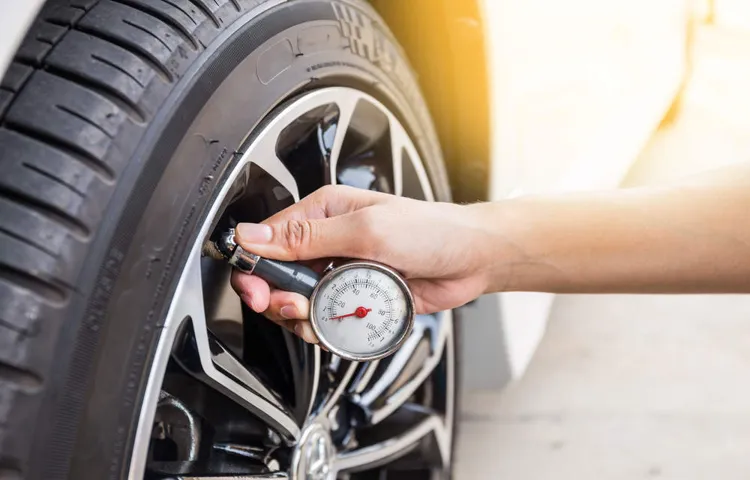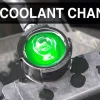Feeling the pressure of low tire pressure? It’s not uncommon to see the warning light on your dashboard, but what causes this issue? And how can you prevent it? Before you start scrambling for answers, let’s take a deep breath and investigate the issue at hand. Low tire pressure can be a nuisance for many drivers, causing uneven tire wear, poor fuel economy, and reduced handling. But fear not, with a little knowledge and diligence, you can stay ahead of the game and keep your tires inflated for a smoother ride.
In this blog post, we’ll dive into the causes of low tire pressure, the steps you can take to keep your tires properly inflated, and the benefits of regular tire maintenance. Let’s get rolling!
Table of Contents
Initial Assessment
If you’ve recently noticed that a tire on your vehicle has low air pressure, the first thing you should do is conduct an initial assessment. A logical way to begin investigating the cause of low tire pressure is to first check the tire’s pressure using a tire pressure gauge. If the pressure is too low, you can use a compressor to pump it up to the appropriate level.
However, if the pressure seems to be at the appropriate level and you are still experiencing a loss of air, there could be a puncture or leak somewhere. In this case, it would be wise to inspect the tire for any visible damage. Additionally, you may want to check the valve stem and wheel for any signs of damage.
Be sure to note any findings and take appropriate action to remedy the situation. Remember, it’s important to address low tire pressure as soon as possible in order to avoid increasing the risk of a blowout or other road hazard. By addressing the issue promptly, you can help ensure the safety of yourself and other drivers on the road.
Checking Tire Pressure Gauge
If you want to ensure a smooth and safe ride, checking your car’s tire pressure is an essential maintenance step. To do that, you need a good tire pressure gauge. But with so many models available on the market, it can be confusing to find the right one.
A useful initial assessment is to determine the type of gauge you need. There are digital, manual, and stick gauges, each with their pros and cons. For example, digital gauges may be more precise, but they require batteries and may malfunction.
On the other hand, manual gauges are more reliable, but they can be challenging to read accurately. Stick gauges are the most straightforward, but they may not provide the precision you need. Once you decide on the type of gauge, you must also consider the range of pressure readings it offers, the accuracy level, and the durability of the device.
Taking these factors into account will help you choose the best tire pressure gauge that suits your needs and enables you to stay safe on the roads.

Visual Inspection of Tires
As a driver, it’s important to keep your tires in top condition for safe and efficient driving. Before you hit the road, take a moment to visually inspect your tires for any signs of wear and tear. Start by checking the tread depth, which should be at least
6mm to ensure proper grip and stability on the road. You’ll also want to look for any cuts, bulges, or punctures in the tire walls, which could indicate a potential blowout. It’s also important to check the tire pressure regularly to ensure proper inflation, which can affect fuel efficiency and handling.
By taking a few minutes to assess the condition of your tires, you can help prevent potentially dangerous situations on the road.
Possible Causes
If you discovered that one of your car tires had low air pressure, the first logical step would be to investigate the possible causes. One possible explanation could be that the tire simply needs more air. It’s common for tires to lose air naturally over time, especially if you haven’t checked their pressure in a while.
Another possible cause could be a puncture or leak in the tire itself. If there’s an object lodged in the tire or if the tire’s valve stem is damaged, this could cause air to slowly leak out. Alternatively, the tire’s sidewall could be damaged and air may be escaping through a small hole or crack.
Checking for these physical damages is essential to figuring out what is causing the low air pressure. Additionally, there could be an issue with the tire’s wheel or rim, causing it to not seal properly and allowing air to escape. By investigating these possible causes, you can easily determine why your tire had low air pressure and address the issue accordingly.
Tire Damage or Puncture
Tire Damage or Puncture – Possible Causes Tires are an essential part of a vehicle, and tire punctures or damages can lead to significant roadblocks while driving. There are many reasons why tire damage or puncture can occur. One of the primary reasons is road conditions.
Cracks, potholes, and debris on the road can cause tire damage and punctures. These conditions can be hard to avoid, especially when driving at high speeds. Another reason for tire damage or puncture is wear and tear.
As tires age, they become less flexible, making them more susceptible to damage. Heat and exposure to harsh weather conditions, such as extreme cold or sun, can also cause tire damage. Additionally, incorrect tire inflation and overloading can increase the risk of tire damage or punctures.
Maintaining your vehicle’s tires with regular inspection, checking air pressure, and rotating them can help prevent tire damage or punctures. However, if you do experience tire damage or puncture, it is important to seek assistance immediately to avoid compromising your safety while driving.
Valve Stem Issues
Valve stem issues can be frustrating for car owners, causing safety concerns and inconveniences. Some of the possible causes of valve stem problems include aging and wear and tear of the valve stems. Exposure to harsh environmental conditions can also lead to stem corrosion and damage.
Poor quality valve stems might easily break or crack under pressure, resulting in costly repairs. Additionally, improper installation and maintenance of valve stems might lead to air leaks, low pressure, and flat tires. Regular inspection and maintenance of your valve stems can go a long way in preventing these issues.
Remember to use high-quality valve stems and to follow the manufacturer’s recommendations for replacement, installation, and maintenance to ensure long-lasting valve stem performance and safety on the road.
Rim Issues
Rim issues are a common problem for car owners, and it can be frustrating to deal with them. There are several possible causes of rim issues, including hitting potholes or curbs, improper installation, corrosion, and uneven tire wear. Hitting potholes or curbs can cause the rim’s structure to bend or warp, leading to issues with wheel balance and alignment.
Improper installation can also cause the rim to become misaligned or uneven, leading to vibrations while driving. Corrosion can also occur due to exposure to harsh weather conditions or chemicals on the road, damaging the rim’s surface and causing leaks. Uneven tire wear can also lead to rim issues, as it puts additional stress on the rim and causes it to wear out faster.
If you’re experiencing rim issues, it’s important to have them checked out by a professional as soon as possible to prevent further damage and ensure your safety on the road.
Leaking Tire Bead
If you have ever experienced a flat tire, you know how frustrating it can be. One possible cause of a flat tire is a leaking tire bead. This occurs when the seal between the tire and the rim is compromised, causing air to leak out.
One common cause of a leaking tire bead is damage to the wheel or tire. The bead may become damaged due to hitting a curb or pothole, causing a small crack that allows air to escape. Another cause may be due to old, worn out tires that are no longer able to maintain a proper seal with the rim.
Additionally, improper installation of the tire may also cause a leaking tire bead. If the tire is not seated correctly on the rim, air can leak out through the small gap. It is important to address any tire bead leaks as soon as possible to avoid further damage to your tire and ensure your safety on the road.
Further Inspection
If you found that your tire had low air pressure, the first logical step would be to inspect the tire for any visible damage or punctures. If you don’t see any obvious issues, move on to checking the valve stem for leaks or damage. Sometimes, the issue could be as simple as a loose or faulty valve stem.
If everything looks good, move on to inspecting the rim for any damage or cracks that could be the culprit of the low pressure. Additionally, make sure that your tire hasn’t worn down to the point where it needs to be replaced. All in all, a tire can lose air pressure for a variety of reasons, with some being more serious than others.
By investigating each potential cause one by one, you can identify the root of the issue and take the necessary steps to fix it. In doing so, you’ll ensure that your car is safe and running smoothly on the road.
Checking for Obvious Damage
When inspecting an item for damage, the first step is usually to check for obvious signs of wear and tear. This can include cracks, dents, scratches, or any other physical damage that may have occurred during use or transportation. However, it’s important to remember that not all damage is immediately apparent.
Sometimes a closer inspection is necessary to uncover less visible issues. This is where further inspection comes into play. By examining an item more closely, you can identify potential problems that may not be obvious at first glance.
This can include inspecting the internal components, looking for signs of corrosion, or testing the item to ensure it is functioning properly. By taking the time to perform a thorough inspection, you can ensure that the item is safe to use and will perform as expected. So, whether you’re inspecting a piece of machinery, a vehicle, or any other item, remember to look beyond the surface to ensure that it is in good working order.
Water Test for Air Leaks
If you suspect that your home or business has air leaks, it’s time to perform a water test. This simple test can help you identify any leaks that may be present, so you can take steps to correct the problem. To start the test, close all doors and windows and turn off any fans or HVAC systems.
Then, take a bucket of water and a sponge and start applying water to the exterior of your building, starting from the bottom and working your way up. As you apply the water, look for any areas where the water is absorbed, as this could indicate air leaks. If you notice any leaks, mark them with a piece of tape or a pen, so you can come back and seal them later.
While a water test can be a helpful tool in identifying air leaks, it’s important to remember that it’s not a substitute for a thorough inspection by a professional. If you’re concerned about air leaks in your building, consider contacting a professional for further inspection and guidance on how to correct the problem.
Maintenance Tips
If you’ve noticed that the air pressure in one of your tires is lower than it should be, the logical way to begin investigating this is to first inspect the tire for any visible damage or puncture marks. If you can’t find anything on the tire itself, you might want to check the valve stem and surrounding areas for any signs of leaking. It’s also possible that the tire pressure monitoring system (TPMS) may not be working properly, so you may need to take your vehicle to a mechanic to have this checked.
Regularly checking your tire pressure and maintaining the appropriate levels is crucial for ensuring your safety on the road and prolonging the life of your tires. Remember to keep a tire pressure gauge on hand and check your tires at least once a month, especially during periods of extreme temperature changes. By taking proactive measures to maintain your vehicle’s tires, you can avoid costly repairs and potential safety hazards down the road.
Conclusion
Well, it’s no mystery that a flat tire can really derail your day. But before you start pointing fingers at the road or blaming your car for being a gas-guzzling monster, it’s important to take a logical approach to the situation. By asking questions, examining the tire’s condition, and looking for signs of wear and tear, you can begin to investigate why your tire had low air pressure like a detective on the case.
So put on your thinking cap, grab a tire gauge, and let’s get to the bottom of this deflated mystery!”
FAQs
What are the common reasons why a tire may have low air pressure?
Low tire pressure can be caused by a puncture, leakage, or temperature changes. It can also be caused by improper inflation or a faulty tire valve.
How often should tires be checked for air pressure?
Tires should be checked for air pressure at least once a month or before going on a long trip. It is also recommended to check the pressure after significant temperature changes.
Is it okay to continue driving with low tire pressure?
No, it is not safe to drive with low tire pressure. It can cause tire damage, reduce fuel efficiency, and increase the risk of accidents.
How can I check the correct air pressure for my tires?
The recommended air pressure for your tires can be found in the owner’s manual or on a placard located on the driver’s side door jamb. It is important to follow the manufacturer’s recommendations.
What should I do if I notice low tire pressure?
You should add air to the tire according to the recommended pressure and check it again after a few days. If the pressure continues to drop, it may be a sign of a puncture or a leak and should be inspected by a professional.
Can tire pressure monitoring systems (TPMS) help prevent low tire pressure?
Yes, TPMS can alert drivers when their tire pressure is low and help prevent damage to the tires. It is important to regularly check and maintain the system to ensure its accuracy.
What are some tips for maintaining proper tire pressure?
Some tips for maintaining proper tire pressure include checking the pressure regularly, inflating tires to the correct pressure, avoiding overloading the vehicle, and driving carefully over sharp objects or potholes that could damage the tires.



